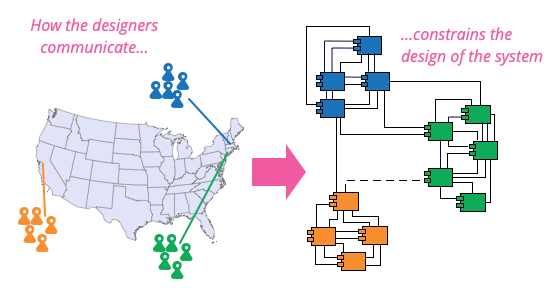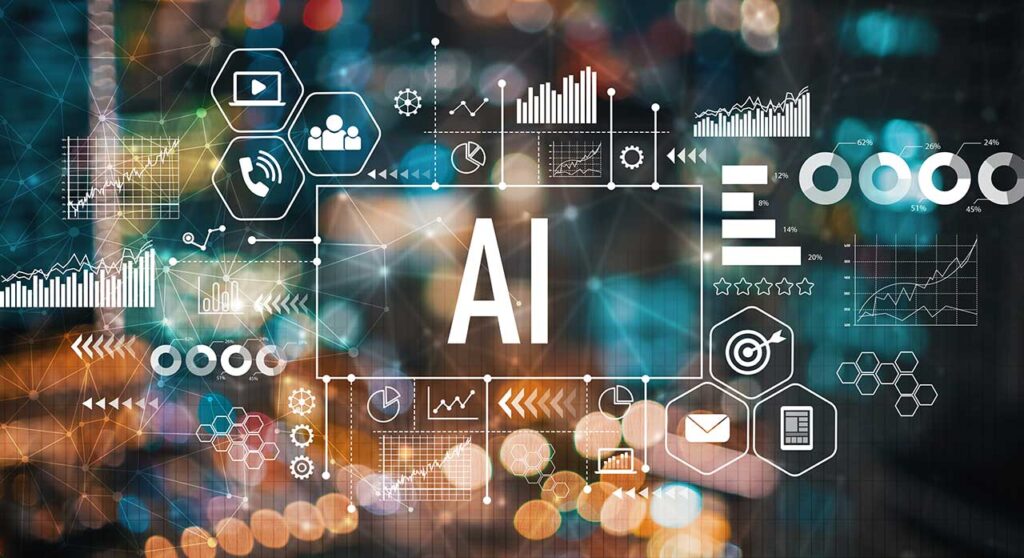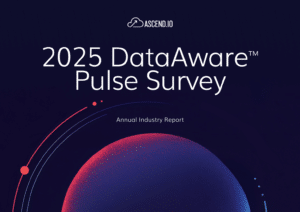Conway’s law states that organizations will invariably design systems that mirror their internal communication and organizational structures. This foundational insight into the very fabric of organizational behavior also applies to how many enterprises are approaching the AI opportunity. If you look closely, the solutions being proposed in your organization will likely reflect current departmental silos, legacy objectives, internal politics, and traditional power centers. This pattern obscures the massive potential that could be unlocked by the emergence of AI as the enabler of large transformational shifts within many organizations.
AI is no longer a futuristic concept; it has been seamlessly integrating into our daily lives for years, through increasing intelligence in marketing, customer service, navigation assistance, and many other applications. LLMs (large language models, a specific type of AI) in the form of OpenAI’s ChatGPT and Google’s Bard are just the latest, more visible wave of these technologies. Their sudden adoption has tipped many enterprises to take stock of AI’s transformative potential for their businesses. Yet, Conway’s Law looms like an invisible hand, hindering the realization of the full potential of AI. Old organizational structures and patterns will assert themselves, often blocking truly transformational shifts that are on offer through these new technologies.
Given this backdrop, the emergence of a new role — the Chief AI Officer (CAIO) — is not just logical, but becomes imperative to ensure that investments in AI capabilities are holistically integrated into the organization, and are structured to yield maximum benefits in the long term. This article delves into the significance of the CAIO, and pinpoints the responsibilities and challenges of leading organizations through the necessary transformation to ensure they can survive and thrive in an AI-driven future.

Visual representation of Conway’s Law (source)
The Parallels Between the AI Revolution and Digital Transformation
A dozen years ago, a similar wave of data and compute technologies coalesced to challenge business as usual for many companies. Startups rapidly harnessed new capabilities in cloud, networking, and personal computing with software that leapfrogged existing enterprises and disintermediated their customer relationships on many fronts. The ensuing response by enterprises became known as digital transformation, and the role of the Chief Digital Officer (CDO) emerged as pivotal in navigating the technical and business complexities of this response.
The CDO was given boardroom-level powers and dedicated budgets to shepherd the business through this transformation, and many took Conway’s Law to heart, ensuring that their charges didn’t simply reproduce their old operational models within a digital world. The most successful CDOs disrupted the status quo, introduced new organizational patterns observed in the startup world, and steered organizations through the creation of new capabilities in the digital realm, unlocking profound new top-line opportunities for their businesses.
Fast forward to today, and businesses stand at the cusp of another transformative era with artificial intelligence (AI). The challenges and opportunities AI presents have striking parallels with those of the digital age:
Pace of Change: Advanced AI models like generative AI, including its blockbuster offspring, large language models (LLMs), have already ushered in significant disruptive potential. Yet AI capabilities are predicted to continue to double every two years, indicating a rapid pace of development similar to the early days of digitalization.
Necessity to Adapt: With AI’s disruptive potential now obvious, the importance of a forward-looking strategy at the executive level is similar to the early days of digitalization. Firms that fail to adapt are at risk of stagnation. Leaders in AI adoption are poised to unlock virtuous cycles of innovation, significantly reducing operating costs, enhancing customer experiences, and discovering novel revenue streams.
Cross-Organizational Integration: Effective AI adoption can’t be isolated to a single department or in an ad-hoc fashion. Like digital transformation, AI demands the cohesion of multiple departments, coordinating technologies, and new team priorities to unlock new business value. Executive alignment is critical to overcoming political dynamics and resistance.
Technological Challenges: Existing technologies harbor entrenched biases about how work is done, further complicating the inertia presented by Conway’s Law. Similar to the central role of technology in digital transformation, the adoption of AI requires a rethinking of the art of the possible, and business units to move out of their old comfort zones.
Centralized Funding: Fragmented investment in AI initiatives within different departments is a recipe for institutionalizing data and technology silos that are likely to yield limited returns. Similar to digital transformation, a centralized funding approach unlocks new capabilities that don’t emerge organically, and drives ROI by directing outcomes that span the organization.
The Need for Visionary Leadership: Just as the digital era required leaders capable of articulating a compelling vision of a digital future specific to their company, the AI era demands leaders to understand the nuances of different AI capabilities and how to structure their deployment throughout their organization. These leaders must know how to augment this technical prowess with political and business acumen to drive high-yield AI initiatives.
In essence, just as the CDO was instrumental in guiding businesses through the digital transformation, the Chief AI Officer (CAIO) is central to navigating the AI revolution. The lessons from the digital era serve as valuable insights for organizations as they embark on their AI journey, ensuring they harness their full potential and don’t merely mirror old practices in a new technological context.
The Responsibilities of the CAIO
Given the complex and multifaceted nature of AI, it is imperative for organizations to delineate clear responsibilities for this crucial role. Here’s a comprehensive breakdown of the responsibilities of the Chief AI Officer:
1. Strategic Leadership: The CAIO crafts a clear and coherent vision for how AI becomes a foundational enabler for all business processes across the organization. Beyond vision-setting, they are responsible for ensuring that all AI initiatives align and seamlessly drive forward the broader business objectives. This alignment ensures that AI is not just a technology project but a strategic pillar of the business.
2. Operational Oversight: The CAIO supervises the roll-out of AI initiatives from inception to execution, and controls the allocation of budget, talent, and technologies to all related projects. The key here is not to create yet another separate business silo, but to establish new capabilities that become transformative catalysts across the enterprise, and track their progress against enterprise-wide KPIs.
3. Ethical and Legal Compliance: Since AI capabilities tend to cross traditional boundaries within the enterprise and beyond, employees, customers, and partners can be affected in new ways that can constitute ethical and legal challenges. The CAIO establishes and enforces frameworks that make sure that all stakeholders’ protections remain intact, and guide the ethical development and deployment of AI-enabled systems and processes. Moreover, they are the custodians of regulatory governance, and ensure that the organization’s AI capabilities comply with applicable industry standards.
4. Data Management: Data is the lifeblood of AI, and the CAIO develops the comprehensive data strategy that aligns the company’s data executives to fuel its AI initiatives. The CAIO is the vanguard of data privacy and security for the new AI-based capabilities. All data used for these purposes, be it organizational or customer-centric, must be handled with diligence and subject to the relevant policies.
5. Innovation and R&D: The rapid pace of evolution in the AI realm demands continuous research to remain abreast of ongoing innovation that addresses vulnerabilities and unlocks new capabilities. The CAIO spearheads these R&D efforts and actively nurtures a culture that values and encourages fresh ideas, and fosters an environment where experimentation with AI is celebrated.
6. Collaboration and Partnership: Enterprise AI initiatives cannot exist in silos and expect to create value for the business. The CAIO is pivotal in ensuring that AI projects include the departments that are affected by the new capabilities, and foster a holistic organizational approach to the adoption of AI. In addition to internal collaborations and restructurings, they also forge meaningful alliances with external stakeholders, including suppliers, customers, startups, partners, and research institutions, to amplify the value that is created with the organization’s AI capabilities.
7. Skill Development and Talent Management: Successful outcomes from AI initiatives hinge on the right talent. The CAIO is instrumental in assembling and leading new teams, and can do so by recruiting engaged and motivated employees, as well as onboard new AI experts to drive the initiatives. They also sponsor skill-enhancement programs that focus on adoption by existing staff, and programs that reward internal champions and heroes.
8. Risk Management: AI is an opportunity that brings along many unknowns, which like all technologies, carry significant risks. The CAIO implements the processes and people that continuously detect potential pitfalls, and can draw on risk managers in cyber, technical, and business domains to devise strategies to mitigate them. Their purview also extends to financial oversight, with responsibilities that AI investments are made with appropriate governance and ultimately yield the desired returns.
9. Customer Experience: One of the most powerful potentials of AI is its ability to redefine customer experiences. The AI capabilities developed under the CAIO are likely to impact many customer touchpoints, including AI insights that materially redefine and innovate the organization’s product and service offerings, and rapid changes and interventions based on real-time customer feedback.
10. Brand and Reputation Management: In the public eye, the CAIO ensures that the organization’s AI endeavors fundamentally enhance its brand reputation, and prevent mishaps that could tarnish the brand. Their responsibilities include proactively communicating the company’s AI milestones to stakeholders and the wider public, and leading the navigation of unforeseen events to minimize their fallout.
11. Scalability and Future-Proofing: The ongoing dynamic evolution of AI demands solutions that can adapt quickly and scale unpredictably. The CAIO’s approach to building AI systems and creating new capabilities that restructure the company’s operations must anticipate the need to adjust course quickly. Their strategies should ensure that the organization’s AI roadmap remains nimble and ready to adapt.
Differentiating the Chief AI Officer from the Chief Data Officer
The Chief AI Officer (CAIO) and the Chief Data Officer (CDO), while operating in interconnected domains, have distinct responsibilities. The CAIO is all about unlocking and integrating AI’s transformative potential into business operations, while the CDO ensures the foundational data upon which these transformations rely is robust, secure, and compliant. Let’s get into the details.
The Chief AI Officer harnesses and deploys the transformative potential of AI to propel the business forward. As we’ve discussed in detail so far, their primary role revolves around strategizing, implementing, integrating and optimizing AI-driven solutions.
They provide for a transition from an organization’s current capabilities to those that are based on AI, and revolutionize its operations. The CAIO ensures that these technologies and restructured workflows align with business objectives, maintain ethical standards, and stay updated with the AI industry’s rapid advancements.
The Chief Data Officer on the other hand maintains the data groundwork upon which these AI initiatives thrive. Their realm is the data that their business generates and relies upon, including data from customers and partners. The CDO is entrusted with fundamental data integrity, privacy, and accessibility of this data as a resource.
The CAIO, on the other hand, crafts governance strategies that govern the use of data by the new AI applications, to comply with evolving AI protection regulations. While CDOs oversee the foundational data infrastructure and tools to access, analyze, and derive business insights from data, the CAIO leads the implementation of platforms and applications that structure data to fuel the new AI capabilities.
Take, for example, a retail organization aiming to implement AI-driven customer recommendations on its e-commerce platform. The CAIO would lead the initiative, deciding on the relevant platforms, structuring the data, and building the applications and models that implement the AI-enabled customer experience, including monitoring post-deployment efficacy.
The CDO would be responsible for making available the right customer data feeding this new capability, assuring that it is accurate and relevant for its intended use. Without the right data infrastructure and governance, even the most well-intentioned AI initiative can falter.
Embracing the Future: The Rise of the Chief AI Officer
The advent of the Chief AI Officer (CAIO) in many organizations is not a short-term trend. As the AI revolution accelerates its influence and weaves deeper into the day-to-day operations of modern business, the need for cross-functional leadership that is dedicated to championing the necessary changes and driving the adoption of the right technologies has become more urgent than ever.
Drawing from Conway’s law, if the response to the AI opportunity is left to emerge organically within an organization, the chances are high that the business will fail to adapt sufficiently, and hamper the transformative journey that is needed to succeed.
The CAIO can step into the spotlight and bring focused leadership that transcends existing organizational patterns, driving the restructuring and cultural change that is necessary for the adoption and integration of AI to meet the strategic goals of the enterprise. The rise of the CAIO underscores a commitment to the innovation and transformation with which businesses don’t merely survive, but truly thrive within the new AI era.





